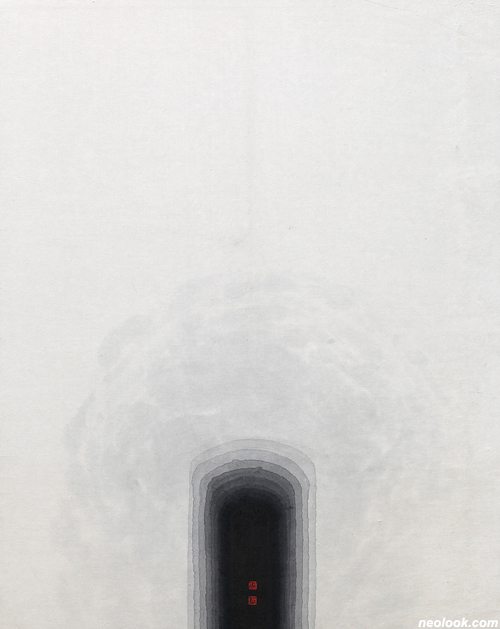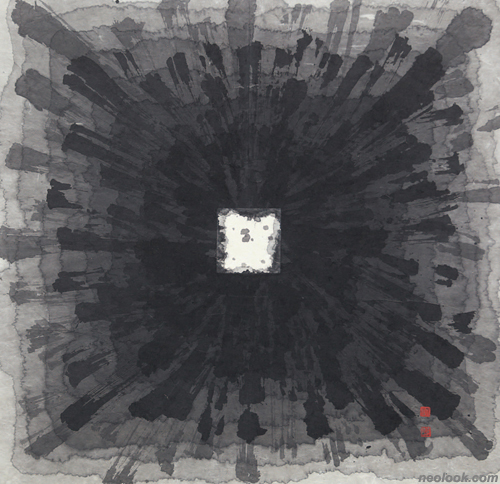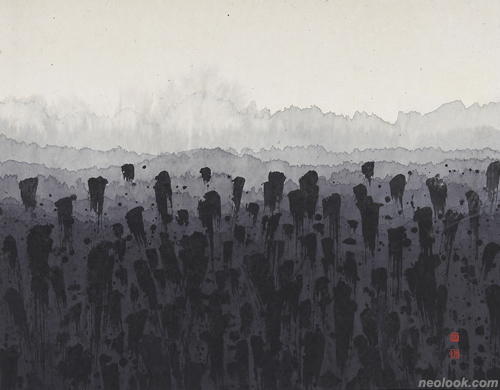- ● homepage
- ● archives
- ● restoration
- ● books
- ● big banners
- ● post board
- ■ neo's search
- ■ about us
- ■ 게재방법 안내
- 개인정보처리방침

- [email protected]
- Tel. 02_335_7922
- Fax. 02_335_7929
- 10:00am~04:30pm
- 월요일~금요일
- 3/3(월) 대체공휴일

순환-생명의 땅
이재승展 / LEEJAESEUNG / 李在昇 / painting 2012_0613 ▶ 2012_0619

- 이재승_심상-명상 Imagery-Meditation_한지에 수묵_162×130cm_2012
초대일시 / 2012_0613_수요일_06:00pm
관람시간 / 10:00am~07:00pm
인사아트센터 전북도립미술관 서울관 JEONBUK PROVINCE ART MUSEUM 서울 종로구 관훈동 188번지 인사아트센터 제1전시실 Tel. +82.2.720.4363 www.jbartmuse.go.kr
이재승의 작품세계 : 순환의 고리를 통한 사유의 세계 ● 칠흑같이 어두운 무질서와 혼돈의 세계는 마치 이제 막 태어난 신생 우주공간의 그것처럼 암흑과 텅 빈 혼돈의 카오스(Chaos)를 연상시키다. 하지만 이내 그런 혼돈의 무질서 속에서도 크고 작은 에너지는 서로 얽히고설켜 새로운 생명체를 머금은 새로운 에너지로 전환되고 있고 이런 카오스적인 혼돈과 무질서 속에 내포되어 있던 역동성과 새로운 에너지는 곧바로 우주를 진동시키면서 새롭게 탄생될 천지(天地)를 뒤흔들고 있다.

- 이재승_생명-현 玄 Vitality-Black (Universe)_한지에 수묵_212×760cm_2012
한국화가 이재승이 이번에 전시하게 될 「생명-현(玄)」이라는 대작(大作)에 대한 느낌이다. 필자가 이처럼 서두에서 마치 창세기의 천지창조나 혹은 중국의 천지창조 신화인 반고(盤古) 신화를 연상시키는 화두로 시작한 연유는 이재승의 「생명-현(玄)」이라는 작품이 이번 전시에서 그가 선보이게 되는 여타의 간결하고 사유적(思惟的)인 작품들과는 달리, 매우 강렬한 느낌을 주고 있을 뿐만이 아니라 이번 전시의 주제 역시 암시적으로 내포하고 있기 때문이다. 이 작품을 부분적으로 바라보면 얼핏 무질서한 것처럼 보일 수도 있지만, 작품 전체를 조망(眺望)하고 있노라면 무질서 속에서도 강렬한 표현력과 함께 조화로움이 엿보인다. 아마도 카오스적인 혼돈과 무질서의 공간 속에 내포되어 있는 역동성과 강렬한 에너지 때문일 것이다. 명말, 절파(浙派)의 계보였던 광태사학파(狂態邪學派)의 오위(吳偉)나 장로(張路), 왕악(王愕) 등이 만취하여 동료의 머리에 먹물을 묻힌 후 화지(畵紙) 위에 끌고 다닌 후 그 흔적을 보면서 즐겼던 것처럼, 이재승의 「생명-현(玄)」이라는 작품 역시 다분히 행위적이고 표현적인 느낌이 매우 강하다. 뿐만 아니라 잭슨 폴록의 액션 페인팅(Action Painting)을 연상시키기도 하지만 폴록의 액션 페인팅이 '행위'하는 장소로서의 화면 그 자체를 중요시 한 반면, 이재승의 이 작품은 자연과 사물들 너머 저 멀리 존재하고 있는 근원적인 생명에 대한 사유와 성찰의 '흔적'으로 존재하고 있다는 점이 사뭇 다르다고 할 수 있겠다. 그의 작품 속 무질서와 질서 사이의 대비와 충돌의 양태 속에서 탄생된 새로운 에너지는 이제 아무것도 존재하지 않았던 텅 빈 공간, 다시 말해 무(無의) 공간에서 새로운 생명체로 재탄생되고 있다.

- 이재승_상생 Being Together_한지에 수묵_76×79cm_2012
한국화가 이재승이 이번 전시에서 선보이고 있는 작품의 주제는 「생명-순환의 땅」이다. 작가가 그 이전에 탐구했던 「심상-명상」 이후의 연작들인 것이다. 이재승의 초기 작품들이 한국화가 담아낼 수 있었던 사물과 자연의 외형적인 '형상(形象)'에 대한 탐구였다면, 최근의 작품들은 사물 자체에 대한 '현상(現像)과 물성(物性)', 다시 말해 사물의 본질 그 자체에 대한 탐구로 완전히 귀결되고 있다는 것을 여실히 보여주고 있다. 따라서 그의 이번 작품들 또한 외적으로는 한결 더 단순화되고 간결한 특성을 보이면서도 역설적으로 작품의 깊이나 내재적인 의미는 작가의 내공만큼이나 더 깊어지고 더 심오해졌다. 고요함 가운데에서도 끊임없는 움직임을 느낄 수 있는 정중동(靜中動)의 느낌이랄까? 세월의 무게만큼이나 자기 자신을 버리고 비워내는 인고(忍苦)와 성숙의 과정을 거쳤음을 짐작할 수 있는 대목이다. 따라서 그의 이번 작품들은 존재하는 모든 대상의 외형이 아닌 원형(原形)을 사유하며 그 본질에 대한 내면의 성찰을 통해 한국화의 근본이 되고 있는 '정신성'에 대한 전통적인 시각과 현대적인 시각과의 조화로움이 단연 돋보이고 있다. 주제 역시 마찬가지이다. 작품의 제목에서도 연상할 수 있는 것처럼, 작가는 「심상-명상」 연작 이후 '생명과 순환'이라고 하는 보다 더 본질적인 문제에 관심을 기울이고 있다. 그의 이번 주제는 우주와 인생을 근원적으로 탐구하는 사상이었던 동양의 노자(老子)와 장자(莊子)의 도가사상(道家思想)과 직접적으로 연결되고 있다. 노자는 만물의 근원을 무(無)라 하였고, 무는 곧 자연이며 이는 생명의 근원을 이룬다고 하였다. 장자 역시 인간의 절대적인 자유와 물아일체(物我一體)를 주장하였다. 이재승의 몇몇 작품에서 꿈속의 나비와 자기 자신을 혼동했던 장자의 '호접지몽(胡蝶之夢)'이 연상되는 것은 필자만의 느낌일까? 아울러 필자가 서두에서도 언급했던 것처럼, 이재승의 작품 역시 아무 것도 없는 무(無)로부터 새로운 생명체가 탄생되고 이러한 생명체는 결국 다시 무(無)의 세계로 돌아가는 순환의 고리를 암시하고 있다.

- 이재승_순환-생명의 땅 Circulation- The Land of Vitality_한지에 수묵_91×116cm_2012
이재승의 이번 작품들은 '흑(黑)'과 '백(白)'이라고 하는 전체적인 특징이외에도, 묵(墨)을 통한 형상과 여백뿐만이 아니라, 구도적으로도 좌우, 혹은 상하 대칭이라고 하는 이중(二重)적인 구조를 특징으로 하고 있다. 하지만 중요한 것은 이재승의 작품에서 보이는 이런 이중적인 구조들이 노자와 장자의 그것처럼, 갈등과 분열을 야기하는 이분법적으로 대립된 경계도 아니고 적대적인 구조 역시 아니라는 것이다. 흑과 백, 여백과 형상 또한 마찬가지이다. 일반적으로 한국화의 '여백(餘白)'은 서양화의 '공간'과는 또 다른 의미를 내포하고 있다. 서양화의 공간이 물리적으로 텅 비어 있는 공간이라면, 한국화의 여백은 작가만의 '호흡'과 '정신'을 담은 '사유(思惟)'의 공간, '성찰(省察)'의 공간, 동시에 '비움'의 공간이기도 하다. 하지만 이러한 구분도 이재승의 작품에서는 무의미하다. 왜냐하면 서양의 공간에 대한 개념이나 동양의 여백에 대한 개념이 근본적으로는 같은 개념으로부터 출발하고 있기 때문이다. 따라서 그의 작품에 등장하고 있는 여백은 작품화면에 자리 잡고 있는 '형상과 색채' 와 분리된 이면(異面)의 공간이나 이분법적으로 분리되는 공간이 아니라 상생(相生)을 위한 공간이자, 이런 상생을 근본으로 탄생된 '채움'의 공간 역시 되기도 한다. 이렇게 이재승의 작품에서 표현되고 있는 여백은 '비움'의 공간이자 역설적으로 무엇인가로 가득 차 있는 공간, 즉 '채움'의 공간이라고 하는 이중적인 의미를 내포하고 있다. 왜냐하면 여백과 공간 역시 순환의 고리에 대한 연장선상에서 해석할 수 있는데, 공간은 '텅 비어있거나' 혹은 '채움과 무한(無限)'을 동시에 의미할 수 있는 순환의 고리이기 때문이다.

- 이재승_순환-생명의 땅 Circulation- The Land of Vitality_한지에 수묵_91×116cm_2012
이처럼 작가 이재승에게 있어 비움과 채움의 공간인 여백과 형상, 혹은 흑과 백은 단절된 사물들과의 소통과 관계의 출발점이자 '생명'의 원천이라고 하는 중요한 의미를 내포하고 있다. 다시 말해 탄생과 소멸, 이성과 감성, 육체와 정신, 앞과 뒤, 양(陽)과 음(陰), 남성과 여성 등 표면적으로는 반대의 개념이거나 혹은 상반된 개념들이 궁극적으로는 상반된 개념이 아니라 한쪽이 있음으로 해서 다른 한쪽이 비로소 존재의 의미를 지닌, 함께 어우러져 갈 수밖에 없는 상보적(相補的)인 관계, 혹은 순환적인 관계로 존재한다는 것을 작가는 이미 오랜 성찰을 통해서 알고 있는 듯하다. 앞(前)이 있기에 뒤(後)가 있고, 남성이 있음으로 해서 여성의 의미가 비로소 존재할 수 있는 것처럼, 소멸이 있기에 탄생의 기쁨과 생명의 소중함 역시 그 진정한 의미를 부여받을 수 있기 때문이다. 이재승의 이번 작품들은 이런 상생의 의미, 순환의 의미를 사유할 수 있는 다양한 장(場)을 제공해주고 있다. 그의 필묵과 먹빛은 또한 어떠한가! 자연을 바라보면서 대상의 모든 것이 먹을 바탕으로 전개되고 있다는 것을 깨달은 작가는 먹의 농담을 통한 여운(餘韻)과 사유(思惟)의 세계를 창조해내고 있다.

- 이재승_상생 Being Together_한지에 수묵_91×116cm_2012
한국화가 이재승은 이처럼 조용하지만 생명력이 담긴 그만의 독특한 조형세계를 통하여 사물들 너머 저 멀리 내포되어 있는 근원적인 생명에 대한 사유와 성찰의 세계를 창조해내고 있다. 지속적인 사유와 성찰 속에 탄생된 그의 작품 속에서 앞으로 거장(巨匠)으로서의 숨결을 기대해본다. ■ 이태호

- 이재승_호접몽 蝴蝶夢_한지에 수묵_146×205cm_2012
The world of Lee Jae-seung's artworks: the world of thinking through a circulation loop ● The world of black disorder suggests an empty chaos of a baby universe. Among the chaotic situation, however, various groups of energy intertwine each other to be transformed into a new energy for the birth of life, where dynamics and this new energy immediately make the universe vibrate and shake the world in creation. ● This is what I feel about 「Life-Black (玄)」, an artwork of Korean painter Lee Jae-seung whose exhibition will soon open. The phrase mentioned above seems to remind the Creation in the Genesis of the Bible, or Bango (盤古) myth of China. That is because in my opinion this work, unlike others shown in the exhibition which mainly tend to display simple and thoughtful characteristics, expresses a very strong feeling and allusively includes in it the theme of this event as well. Seen at a glance, this work might look confused or disordered, but if you give it a comprehensive approach you could not only feel strong expressions but also some kind of harmoniousness in it. These feelings might probably come from dynamics and a strong energy which are involved in the space of chaotic confusion and disorder. As when O-wi (吳偉), Jang-ro (張路) and Wang-ak (王愕) of the School of Gwangtaesahak (狂態邪學派) at the end of Ming Dynasty of China, all dead drunk, smeared black ink on their friends' head and dragged them onto a drawing paper to enjoy looking at the traces, 「Life-Black(玄)」 truly gives me much behavioral and expressive feelings. In addition, it also reminds me of Jackson Pollock' action painting, but while his emphasizes the canvas itself as a place for his action, Lee's 「Life-Black(玄)」 exists as 'traces' of thinking and reflection about a fundamental life which is far beyond nature and things. A new energy created among contradiction and collision between order and disorder is now being re-created as a new life in the space of nothingness, an absolute empty space that never could be seen before. ● The theme of the exhibition, 「Cycle-Life Earth」, is one of the sets of the previous 「Image-Meditation」. While his early works are focused on exploring external 'forms' of things and nature, which are mainly used in Korean painting, in his recent works, he is clearly indulged in studying 'phenomenon and physical properties', namely the pure essence of things. Therefore, artworks of this exhibition feature more simplicity in their appearance but at the same time paradoxically show the condensed feeling of depth in their meaning, just like an endless movement in silence. They reveal the fact that the artist has unyieldingly endured hard times and made his own way. The artworks of this exhibition seek the archetype – and not the appearance - of all things that exist, and ultimately pursue harmony between the traditional viewpoint and the modern one of 'mentality', which is considered a basis of Korean painting through inner mind-reflection about their essence. The same applies to the theme of this exhibition. As you can imagine from the title, Lee has been more interested in the more essential issue of 'Life and Cycle' after his 「Image-Meditation」. His theme is directly associated with Taoism which was an ideology founded by Chinese thinkers Lao-tzu and Zhuangzi, who tried to find the essence of universe and human life. Lao-tzu said that the essence of all things is nothingness (無), which is the very nature and plays the role of a foundation for all life. Zhuangzi also suggested an absolute freedom of human and the unity of man and nature. Looking at some of his artworks, am I the only one who recalls Zhuangzi's famous 'Butterfly Dreams', where the author confused himself with a dream butterfly? As I said before, artist Lee's works imply creation from nothing and the return to nothingness in the manner of a circulation loop. ● These artworks show generally 'black(黑)' and 'white(白)', completed by the features of form and blank through ink and a double structure of the symmetry between up and down or left and right together. However, what is important is that this structure is neither an adversarial boundary that causes conflict and schism nor a hostile structure, instead opposing to the philosophy of Lao-tzu and Zhuangzi. This also applies to black and white, blank and form. 'Blank' in Korean painting has a different meaning, when compared with 'space' in Western painting. While space in Western painting refers merely to a blank space, from the perspective of Korean painting it is a place for thinking, reflection and at the same time 'emptiness' where the artist's 'tone' and 'mentality' are formed. Such classification, however, is meaningless to Lee, because those different concepts about space have the same root in essence. Therefore, blank shown on his works is not a place for separation of things, but for their harmonious co-existence and for the 'filling-up' which are created based on such co-existence. In that sense, his works have a double meaning of having both 'emptiness' and 'filling-up' in the blank. It is because blank and space are on the process of cycle, where nothingness and creation tend to repeat their birth and extinction over time. ● For artist Lee Jae-seung, blank and form - a space for emptiness and filling-up, or black and white is the starting point of communication and relations-making and the original source of 'life' as well. That is to say, birth and extinction, reason and sensibility, body and soul, the front and back, yin (陰) and yang (陽), men and women, all seemingly opposed to each other, are not ultimately contrasting concepts but complementary or circulatory ones which help the survival of each other, and it seems that Lee has already fully understood the truth through his long reflection process. Such contradiction could find its true meaning in their harmonious repetition. Lee's works provide much room to speculate about the meaning of co-existence and the meaning of cycle. You should also notice his ink and its color. Realizing that ink leads all things of nature on the paper, he creates the world of thinking and an aftereffect through a shade of ink. ● Lee Jae-seung creates the world of thinking and meditation of the essential life beyond things with his unique view of quiet but active vitality. Before the works made by his continuous thinking and meditation, I earnestly hope he would successfully build his own world of art as a maestro. ■ Lee Tae-ho
Vol.20120612g | 이재승展 / LEEJAESEUNG / 李在昇 / painting
